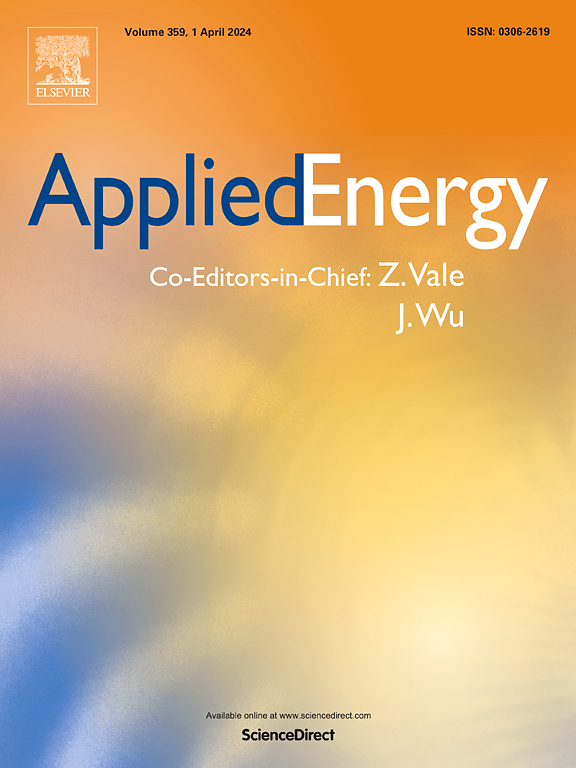Design strategies for mainstream flow channels in large-area PEMFC: From typical units to large areas
IF 11
1区 工程技术
Q1 ENERGY & FUELS
引用次数: 0
Abstract
Developing a large-scale flow field is essential for high-power proton exchange membrane fuel cells. A typical small-scale unit should be expanded to create the mainstream zone of a large-area flow field. This study investigated various design strategies for area magnification through numerical analysis. The impacts of channel length, number of channel branches, scaling factor, and channel/rib ratio on cell performance were thoroughly analyzed. An extraction method for concentration loss was devised to evaluate the primary voltage loss, and a contribution factor was determined. It was found that adding channel branches and proportional amplification led to a performance decline of 4.3 % and 42.6 %, respectively. However, extending channel length can slightly improve the PEMFC power density by 0.5 %–3.4 %. All three area magnification methods affect the bulk concentration in the channel, thereby influencing concentration loss. Moreover, proportional amplification and increasing C/R ratio can also deteriorate the mass transport ability from channel to porous electrode. When adjusting the channel length and C/R ratio, concentration loss is emerged as the primary factor driving performance differences, with a contribution factor exceeding 80 %, significantly higher than the other two voltage losses. However, in the case of altering the number of branches and proportional amplification, ohmic or activation loss also plays a crucial role. The performance of large-area fuel cells will be significantly improved if the area amplification strategy is selected reasonably. Among the three area magnification strategies, adding channel branches is suggested, considering both pump loss and performance degradation. For channel lengths exceeding 100 mm, the pump power density increased exponentially (more than eight times), which is unfavorable. Proportional amplification may lead to a substantial decline (>40 %) in cell output performance.
大面积PEMFC主流流道设计策略:从典型单元到大面积
发展大规模的流场是大功率质子交换膜燃料电池的关键。典型的小型机组应扩大规模,形成大面积流场的主流区。本研究通过数值分析探讨了不同的面积放大设计策略。深入分析了通道长度、通道分支数、比例因子和通道/肋比对蜂窝性能的影响。设计了一种萃取浓度损失的方法来评估一次电压损失,并确定了贡献因子。结果发现,增加通道支路和比例放大分别导致性能下降4.3%和42.6%。然而,延长通道长度可以略微提高PEMFC功率密度0.5% - 3.4%。三种面积放大方法都会影响通道内的体积浓度,从而影响浓度损失。此外,比例放大和C/R比的增加也会降低从通道到多孔电极的传质能力。当调节通道长度和C/R比时,浓度损失成为驱动性能差异的主要因素,其贡献率超过80%,显著高于其他两种电压损失。然而,在改变分支数量和比例放大的情况下,欧姆或激活损失也起着至关重要的作用。合理选择面积放大策略,可以显著提高大面积燃料电池的性能。在三种区域放大策略中,考虑到泵的损耗和性能下降,建议增加通道分支。当通道长度超过100mm时,泵的功率密度呈指数增长(超过8倍),这是不利的。比例放大可能导致细胞输出性能大幅下降(> 40%)。
本文章由计算机程序翻译,如有差异,请以英文原文为准。
求助全文
约1分钟内获得全文
求助全文
来源期刊

Applied Energy
工程技术-工程:化工
CiteScore
21.20
自引率
10.70%
发文量
1830
审稿时长
41 days
期刊介绍:
Applied Energy serves as a platform for sharing innovations, research, development, and demonstrations in energy conversion, conservation, and sustainable energy systems. The journal covers topics such as optimal energy resource use, environmental pollutant mitigation, and energy process analysis. It welcomes original papers, review articles, technical notes, and letters to the editor. Authors are encouraged to submit manuscripts that bridge the gap between research, development, and implementation. The journal addresses a wide spectrum of topics, including fossil and renewable energy technologies, energy economics, and environmental impacts. Applied Energy also explores modeling and forecasting, conservation strategies, and the social and economic implications of energy policies, including climate change mitigation. It is complemented by the open-access journal Advances in Applied Energy.
 求助内容:
求助内容: 应助结果提醒方式:
应助结果提醒方式:


